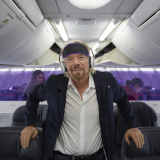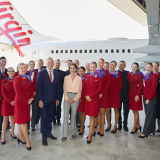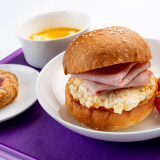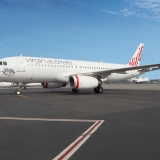Virgin Australia Holdings Limited (ASX: VAH) reports Financial Results for Full Year Ended 30 June 2015
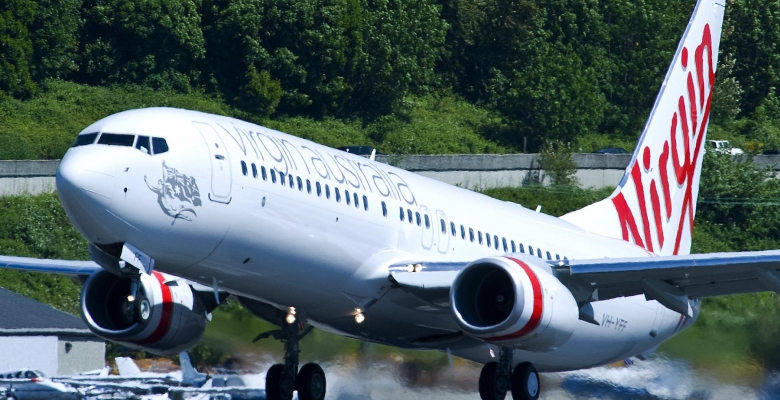
Virgin Australia Group Financial Summary
Underlying Loss Before Tax of $49.0 million, an improvement of $162.7 million on FY14
Statutory Loss After Tax of $93.8 million, an improvement of $260.0 million on FY14
Return on Invested Capital increased to 6.1%, an improvement of 4.7 percentage points on FY14
Positive Operating Cash Flow of $218.1 million, an improvement of $225.8 million on FY14
Total cash position of $1,028.5 million, up from $783.8 million at 30 June 2014, unrestricted cash position of $718.9 million, up from $541.0 million at 30 June 2014
Financial leverage improved by 20% on FY14, notwithstanding a weaker Australian dollar
• Positive Virgin Australia Group Yield and Domestic Yield growth on FY14
Underlying Group CASK excl. fuel and FX reduced by 6.4% on FY14, Virgin Australia CASK excl. fuel and FX reduced by 4.6%
Results Highlights and Outlook
Strong turnaround in Virgin Australia Domestic business with EBIT of $111.1 million, an improvement of $210.1 million on FY14, and on track for further margin improvement for FY16
Significant improvement in Tigerair Australia performance, with EBIT up by $42.7 million. On track to achieve full year profitability for FY16
Comprehensive improvement plan underway for International Business, expected to be profitable by the end of FY17
18.5% growth in Velocity Frequent Flyer revenue, with an average of more than 4,300 joins per day in the last quarter of FY15. EBIT growth of 8% in FY15 and expecting a minimum of 15% earnings growth per annum for FY16 and FY17
On track to deliver a 25%-30% improvement in financial leverage for FY17
Based on current market conditions, Virgin Australia Group expects to return to profitability for FY16 and generate a Return on Invested Capital in line with its cost of capital for FY16, which is approximately 10%
Virgin Australia Holdings Limited (Virgin Australia Group or “the Group”) (ASX: VAH) today reported an Underlying Loss Before Tax of $49.0 million for the 2015 financial year, including the impact of 100 per cent consolidated Tiger Airways Australia Pty Limited (Tigerair Australia) performance from 17 October 2014.
Virgin Australia Group Chief Executive Officer John Borghetti said: “The Virgin Australia Group has delivered a significant improvement in performance for the 2015 financial year, which reflects the positive trajectory of the overall business.
“Over the past financial year, the Group’s Return on Invested Capital has increased from 1.4 to 6.1 per cent. Improving our Return on Invested Capital will continue to remain a strong focus for the Group. I’m pleased to confirm that based on current market conditions, all fundamental business metrics are on track for the Group to return to profitability and report a Return on Invested Capital in line with its cost of capital for the 2016 financial year. The Virgin Australia Group’s current cost of capital is approximately 10 per cent.
“Unit revenue is increasing, unit costs are decreasing and operational performance and customer satisfaction continue to improve.
“Unit cost declines are a result of the Group’s disciplined execution of our $1 billion cost reduction program. The Group has continued to decrease Underlying CASK while investing in the customer experience. Additionally, the full acquisition of Tigerair Australia has given us further capability to lower the Group’s unit costs.
“The Group is ahead of our target of $1 billion of cumulative cost savings by the end of financial year 2017. We are now on track to achieve in excess of $1.2 billion in cumulative cost savings by this date, excluding fuel pricing and hedging benefits.
“The Group’s balance sheet is also in a much stronger position, with the highest ever full year unrestricted cash balance, a $225.8 million improvement in Operating Cash Flow and a 20 per cent improvement in financial leverage on the 2014 financial year.
“I’m pleased to report that we are seeing strong results from the transformation of Virgin Australia Domestic. The business reported an Underlying EBIT of $111.1 million for the 2015 financial year, an improvement of $210.1 million on the prior corresponding period.
“Over the 2015 financial year Virgin Australia Domestic has continued to drive positive yield growth, led the major carriers in On Time Performance and achieved record customer satisfaction with the end-to-end customer experience . Based on results reported to date since financial year 2013 , Virgin Australia Domestic has narrowed the Revenue per Available Seat Kilometre differential versus our major competitor and retained our strong cost advantage. The business is well positioned for future growth.
“Whilst there are challenges on the international front, we are confident with our improvement plan.
“The Group’s unit revenue gains combined with our continued leadership on cost will drive earnings growth going forward. We now have a strong balance sheet from which to execute our strategy and a powerful portfolio of growth businesses in Velocity Frequent Flyer, Charter, Cargo and Tigerair Australia, that will support the Group’s ongoing earnings development and diversification.
“Our people have demonstrated enormous skill and dedication in their disciplined execution of the Virgin Vision strategy”, Mr Borghetti said.
Group Financial Performance
The Group reported an Underlying Loss Before Tax of $49.0 million for the 2015 financial year, an improvement of $162.7 million on the 2014 financial year. Taking into account 100 per cent of Tigerair Australia performance on a like-for-like basis, the 2015 financial year underlying performance represents a $213.0 million improvement over the prior corresponding year.
The Statutory Loss After Tax for the 2015 financial year was $93.8 million, an improvement of $260.0 million on the prior corresponding period.
Return on Invested Capital for the 2015 financial year was 6.1 per cent, an improvement of 4.7 percentage points on the prior corresponding period.
Total Group Revenue and Income increased 10.3 per cent to $4,749.2 million compared to the 2014 financial year, inclusive of $284.1 million of Tigerair Australia revenue since 17 October 2014.
Group Underlying Cost per Available Seat Kilometre (CASK) reduced 6.4 per cent excluding fuel and foreign exchange for the 2015 financial year compared with the prior corresponding period. Virgin Australia CASK reduced 4.6 per cent excluding fuel and foreign exchange over the same period.
Several major cost reduction initiatives contributed to this result, including Airbus A330 fleet rationalisation, sales channel optimisation, insourced line maintenance, major fuel consumption initiatives and savings in procurement.
The decline in oil prices led to a benefit of approximately $60 million for the Virgin Australia Group, compared with the same period in the 2014 financial year, however this was partly offset by the approximately $35 million negative impact of a weaker Australian Dollar on operating costs. The Group derived a hedging benefit of approximately $31 million in the prior corresponding period which impacted the year on year gain. Based on the Virgin Australia Group’s current hedging position and market rates, the Group expects a fuel pricing net benefit of approximately $162 million in the 2016 financial year. However this is expected to be offset by the approximately $99 million adverse impact of a weaker Australian Dollar, resulting in a total expected net benefit of approximately $63 million in the 2016 financial year.
The Group incurred $70.2 million of restructuring and transaction costs during the 2015 financial year as a result of fleet initiatives, costs associated with various transactions and other transformation initiatives. The business also incurred $27.4 million in hedging ineffectiveness costs and time value movement on cash flow hedges.
The Virgin Australia Group finished the year with a total cash balance of $1,028.5 million and an unrestricted cash balance of $718.9 million, up $244.7 million and $177.9 million respectively on 30 June 2014. The Group’s financial leverage ratio improved from 7.5x in June 2014 to 5.9x in June 2015 and is on track to achieve a further 25 to 30 per cent reduction by the end of financial year 2017.
The Group continues to invest in the latest generation of aircraft to support fuel efficiency, operational performance and customer satisfaction. During the 2015 financial year, the Group converted four Boeing 737-800 deliveries for 2016 into Boeing 737-MAX aircraft. Consequently the Virgin Australia Group will now receive 40 deliveries of Boeing 737-MAX aircraft from 2018 onwards.
Segment Performance
Virgin Australia Domestic
Virgin Australia Domestic reported Underlying EBIT of $111.1 million for the 2015 financial year, an improvement of $210.1 million on the prior corresponding period. Operating margins improved from -3.1 per cent to +3.4 per cent.
Revenue increased by 4.8 per cent on the 2014 financial year on capacity growth of 1.3 per cent, driven by growth in the Corporate and Government, Charter, Interline and Codeshare segments. The business remains on track to reach its target of 30 per cent of revenue from the Corporate and Government segment by 30 June 2017.
Virgin Australia Domestic Yield increased by 5.2 per cent compared to the 2014 financial year; driven by success in attracting increased share of higher-yielding market segments.
Virgin Australia Domestic led the major carriers in On Time Performance for the 2015 financial year, achieving 87.9 per cent of flights on time.
External research confirmed that Virgin Australia Domestic achieved record levels of satisfaction with the end to end customer experience, Domestic Business Class service and the lounge experience. The business also won a number of prestigious awards during the period, including Best Airline Staff Service Australia/Pacific by the Skytrax World Airline Awards for the fifth consecutive year.
In the 2015 financial year Virgin Australia Domestic completed the transition to a contemporary full service airline, including:
The rollout of complimentary food, baggage and entertainment across the mainline domestic network;
Completion of wireless in-flight entertainment roll-out across the entire Boeing 737-800 and Embraer 190 fleets;
Launch of Darwin and Alice Springs lounges, expansion of Brisbane lounge and launch of Premium Exit at Melbourne Airport;
A new international standard Business Class service on the Airbus A330s; and
The painting of the last red Virgin Blue aircraft in the new Virgin Australia livery.
Virgin Australia International
Virgin Australia International reported an Underlying EBIT of -$68.9 million for the 2015 financial year, a decline of $22.8 million on the prior corresponding period.
Virgin Australia International revenue decreased by 3.3 per cent compared to the 2014 financial year on a capacity decline of 0.4 per cent.
Increased competitive pressure, particularly in the South East Asian and long-haul markets, constrained yield recovery during the financial year.
In recent months, the Virgin Australia Group has put into place the first phase of initiatives to improve the performance of the international business, including introducing Business Class on the Tasman and Pacific Islands routes to drive further unit revenue growth; integrating the management of the New Zealand operations into the rest of the international business; consolidating its Los Angeles flying from three to two Australian hubs; and announcing the introduction of new Business Class suites on the fleet of long-haul Boeing 777 aircraft to drive further yield growth.
As a result, Virgin Australia International has begun to show improvement, with Underlying EBIT improving by $2.4 million in the second half of the 2015 financial year compared to the prior corresponding period.
Today Virgin Australia has announced the second part of the plan to improve performance. This involves launching the Tigerair Australia brand in the short-haul international market, to enable the Group to better cater to the changing dynamics in the region.
It also enables Virgin Australia International to redeploy some capacity to meet increased customer demand on strong-performing routes and to withdraw Virgin Australia International from routes where market structures have changed.
Further information on the plan is available in the International Update media release distributed today.
Charter and Cargo
Virgin Australia Charter continued to deliver revenue growth during the 2015 financial year.
Despite the slowdown in the resources industry, demand from Virgin Australia Charter’s existing blue chip client base continued to grow during the 2015 financial year and the business won several significant new resources contracts from competitors. This growth has been supported by the addition of four Fokker 100 aircraft, expanding the charter fleet from 20 to 24 aircraft.
The charter customer experience was also further aligned with Virgin Australia’s mainline operations, including the installation of check-in kiosks and gate scanners at three of its largest charter airports.
Virgin Australia Cargo is the Group’s newest business division. During the 2015 financial year, the Group’s dedicated cargo team implemented a state-of-the-art IT system, which will enable the division to optimise cargo capacity and provide tracking and customised reporting to customers.
The business officially launched on 1 July 2015, providing services for major freight distributors, corporate shippers and individuals. Virgin Australia Cargo has already signed several major clients.
Velocity Frequent Flyer
Velocity Frequent Flyer reported an 18.5 per cent increase in revenue and an 8.0 per cent increase in Underlying EBIT to $81.2 million for the 2015 financial year.
Revenue and earnings growth were driven by record annual growth in members, strong member engagement and new partnerships. Velocity invested significantly in people and systems in the 2015 financial year which will drive stronger earnings growth going forward, with a minimum of 15 per cent earnings growth per annum expected in the 2016 financial year and the 2017 financial year.
During the 2015 financial year, Velocity added the highest number of members since the program’s launch, with an average daily join rate of more than 2,400 per day, up from around 1,900 during the 2014 financial year. This significant increase was supported by Velocity’s Australian-first partnership with one of the country’s largest fuel retailers, BP, with an average of more than 4,300 people joining the program per day during the last quarter of the 2015 financial year.
Velocity continued to achieve numerous awards during the 2015 financial year, including winning three prestigious accolades at the Freddie Awards, in which Velocity has been recognised as having Best Redemption Ability in the Asia-Pacific region for three consecutive years. The program also ranked as number two globally for Seat Availability in the Ideaworks SwitchFly Survey.
In July 2015, Velocity acquired a leader in the data and analytics field, Torque Data, enabling the business to significantly expand its capabilities in this field and support its ongoing growth.
Tigerair Australia
Tigerair Australia recorded an EBIT loss of -$8.6 million from 17 October 2014 to 30 June 2015. On a standalone basis, it recorded an improvement of $42.7 million on the prior corresponding period.
The business achieved significant progress in driving incremental revenue growth and delivering cost synergies, with approximately $7 million in benefits achieved as a result of the completion of the Group’s full acquisition of Tigerair Australia.
During the 2015 financial year Tigerair Australia’s average load factors improved by 1.8 percentage points to 86.1 per cent, on capacity growth of 9.6 per cent.
The business introduced a number of initiatives to improve the customer experience while streamlining costs, including check-in kiosks at major airports and an iPad-based mobile app that makes the check-in and boarding process more efficient while enabling additional revenue opportunities. The most recent external survey results show customers were 75 per cent satisfied overall with their Tigerair Australia experience, up 11 percentage points since October 2014.
Tigerair Australia delivered a significant improvement in On Time Performance, with average departures On Time Performance increasing by more than six percentage points during 2015 financial year, finishing the year with 89.0 per cent of flights on time in June and outperforming its major competitor in five of the first six months of the 2015 calendar year .
Conclusion and Outlook
Virgin Australia Group Chief Executive Officer John Borghetti said: “Our people and their dedication to going above and beyond in their day-to-day roles is central to our success in delivering on our Virgin Vision strategy. I would like to thank all of our team members for their commitment to our customers and their tireless efforts in bringing to life the Virgin Vision.
“As a result of the progress on our strategy to date, we are now on a positive trajectory and on track to significantly improve financial performance again for the 2016 financial year.
“Based on current market conditions, all fundamental business metrics are on track for the Group to return to profitability and report a Return on Invested Capital in line with its cost of capital for the 2016 financial year. The Virgin Australia Group’s current cost of capital is approximately 10 per cent”, Mr Borghetti said.

